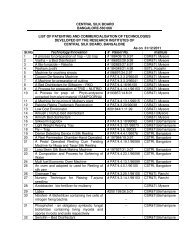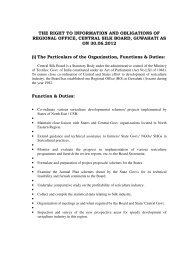RCS Section - Central Silk Board
RCS Section - Central Silk Board
RCS Section - Central Silk Board
Create successful ePaper yourself
Turn your PDF publications into a flip-book with our unique Google optimized e-Paper software.
21<br />
22<br />
23<br />
24<br />
25<br />
26<br />
27<br />
28<br />
Application of<br />
biofertilizer at<br />
nursery level<br />
Integrated<br />
Management Of<br />
Mulberry Pest And<br />
Diseases Developed<br />
<strong>Silk</strong>worm Disease<br />
Management<br />
Technology for<br />
mulberry tree<br />
cultivation under<br />
temperate<br />
condition:<br />
Integrated Pest and<br />
Diseases<br />
Management PM<br />
Package of practices<br />
for mulberry<br />
cultivation on sloppy<br />
land in hilly areas of<br />
Uttaranchal:<br />
Multiplex PCR<br />
technique<br />
Seed crop rearing<br />
technology<br />
Nitrofert inoculum to be made by adding water (1:1<br />
ratio) so as to make a thick paste.<br />
Basal ends of mulberry cuttings to be dipped in the<br />
slurry upto a depth of 10 cm for 30 minutes.<br />
250 grams of Nitrofert biofertilizer is required for<br />
1000 cuttings.<br />
Inoculated saplings to be uprooted with intact root<br />
system from nursery and transplanted in the field.<br />
Glyphodes pyloalis has been identified as a severe<br />
pest of mulberry in temperate region and<br />
Mimastra cyanura in sub-tropics of the state. The<br />
management practices of both these pests has<br />
been worked out by the Institute and<br />
recommendations made accordingly.<br />
A complete IPDM module has been developed by<br />
the institute for control of mulberry pests and<br />
diseases.<br />
Under North Indian conditions, Grasserie has been<br />
found most prevalent and its prevalence is about<br />
25 to 32 % at farmer’s level. The crop loss<br />
estimation is in the range of 11 - 14 Kg per 100<br />
DFLs. The institute has developed an integrated<br />
disease management package to minimize the crop<br />
loss caused due to this disease and other diseases<br />
as well.<br />
Developed Package and practice Viz., Top clipping<br />
in march and bottom pruning in June for<br />
maximization of leaf yield in rainfed condition.<br />
Developed technology of Integrated Management<br />
of Mulberry Pests and Diseases in Kashmir Region:<br />
integrated pest and disease management (IPDM)<br />
module having all the components compatible<br />
with the agronomical practices for mulberry<br />
cultivation is outcome of the study.<br />
Developed package of practices for cultivation of<br />
mulberry on different slopes of land with soil<br />
moisture conservation and water management<br />
practices to increase mulberry acreage in hilly areas<br />
for production of Bivoltine silk in the state for<br />
sustainable sericulture development.<br />
Multiplex PCR technique has been developed (using<br />
degenerate and non-conventional primers) for the<br />
simultaneous detection of different pathogens<br />
NPV, DNV and Microsporidia causing Grasserie,<br />
Flacherie and Pebrine diseases in silkworms. The<br />
technique is being used for testing P3 layings to<br />
detect the pathogens at an early stage.<br />
Eco-friendly technology package for seed crop<br />
rearing has been formulated<br />
27













